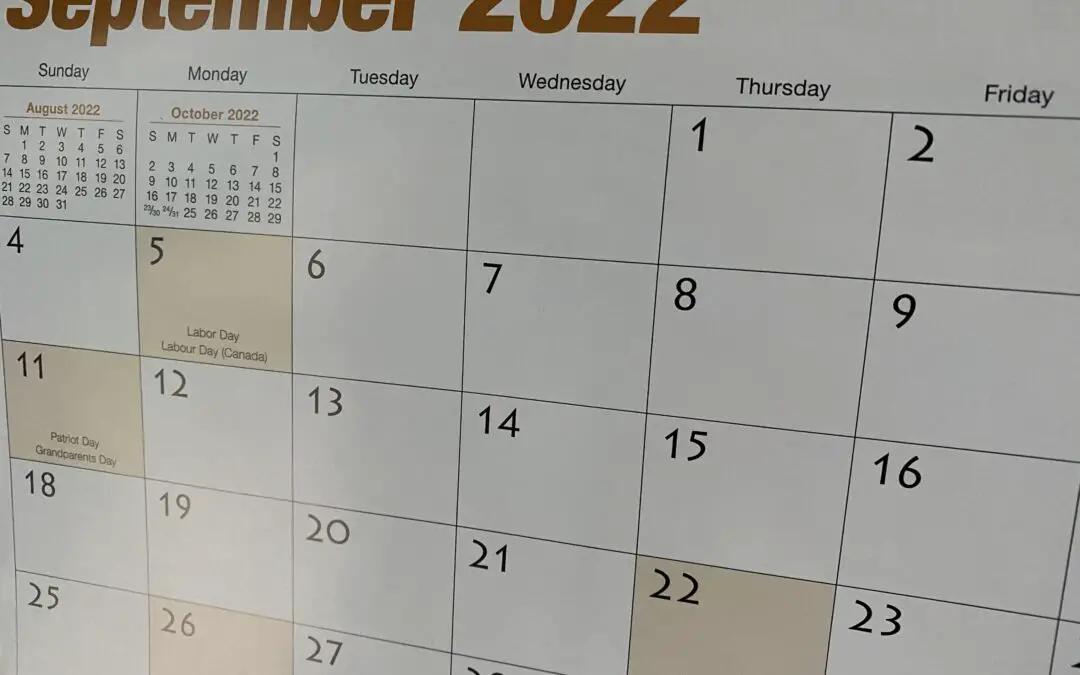All incoming college freshman and international students need to understand the basics of how an academic year is setup within the university, college or community college they plan to attend after high school. Here is a list of some basic questions and answers about the school year calendar in order to better understand how your first school year will unfold.
How many weeks in a college semester?
A college academic calendar year typically consists of two semesters per year with a summer term in-between. And typical college semesters consist of 15-weeks or 75 school days, which tends to be the norm, but this can vary from school to school. Most schools will make the semesters the same length.
How many semesters in a college academic year?
Most colleges run on a two semester system. Each academic calendar year typically consists of a Spring and Fall semester with the option to take additional classes during the summer term. A handful of colleges run on a quarterly or trimester system.
What does the Fall Semester look like at college?
The fall semester is the first semester of the academic year, but the second semester of the calendar year. It can start in late August up to the beginning of September and the last day falls in December. Full-time college students will take anywhere from 12 to 18 credit hours per fall semester. At least 12 credit hours must be taken to maintain full-time student status.
New students and transfer students usually start their classes in the Fall Semester. Therefore, each fall semester schedule has many events that take place before classes begin. So you want to make sure these important dates are on your calendar. At the end of the Fall Semester, there is an additional week allocated to taking final exams.
Most U.S. colleges will give students various days off from classes for holidays. The most common days to get off in the fall semester are the Labor Day holiday and 2 or more days off for Thanksgiving. After the fall semester ends, the winter recess or winter break begins, which is typically 3 to 4 weeks long. The end dates will vary from school to school along with the date you will receive your final grades.
What does the Spring Semester look like at college?
The spring semester is the second semester of the academic year, but the first semester of the calendar year. Full-time college students will take anywhere from 12 to 18 credit hours per spring semester. The spring semester starts in January and ends in May.
Most universities will offer a Spring Break within the spring semester which is typically a week off. In addition to spring recess, most schools allow students to be off on Martin Luther King day. And the end of the Spring Semester, there is an additional week allocated to taking final examinations after completing spring classes.
It is important to note most schools have their registration dates for each semester and summer classes many weeks before the academic terms begin and the ability to register for classes will remain open for weeks before classes begins. Popular classes for a particular semester or term can fill up quickly so it is important to know the exact date registration for classes begins. The sooner you registrar the better you chances are at getting the classes you want.
What does a Summer Term look like for a college?
The Summer Term falls in-between the Spring and Fall Semesters and is typically 12 weeks long. During this term students have many options. Students can use this term to work full-time, intern at a company within their field of study or take accelerated summer courses which typically last between 6 to 10 weeks. During the summer session most schools will consider Memorial Day and Independence Day as a holiday and will cancel class for those days.
In the summer term, students will take fewer summer classes than they would during the spring or fall semester. Most students typically take 3 to 6 credit hours of classes over the summer term. A lot of students use the summer term to gain additional college credit in order to graduate earlier or to reduce the class work load for upcoming semesters. The summer term is a great time to take online courses from a cheaper college knowing the courses will transfer to the college they are currently attending. Depending on your goals, you can use the summer terms as an optional summer semester.
Do some colleges have different academic calendars?
Not every college or university follows the two semester plus summer term academic calendar model. Here are some alternative systems some colleges implement:
– What does a trimester system look like at college?
A trimester system is a system of academic periods that divides the academic year into three parts. The first trimester starts in September and ends in December, the second trimester starts in January and ends in March, and the third trimester starts in April and ends in June.
The length of each period varies from school to school but it usually lasts for about 12 weeks. The first two periods are shorter than the third one because they have fewer holidays.
A school using the trimester system will typically have a shorter summer session compared to a school using the semester system.
– What does a quarter system look like at college?
A quarter system divides the academic year into four quarters. The quarters are usually 10 weeks long and typically named after the seasons. Therefore, students will have a Winter quarter, Spring quarter, Summer quarter and a Fall quarter.
The first quarter starts in September and ends in December, the second quarter starts in January and ends in March, the third quarter starts in April and ends in June, and the fourth quarter starts in July and ends in September. When considering a school running on a quarter system, make sure you understand how classes would transfer to a different school using a semester system.
Why it is important to know your school’s semester system?
When planning how soon you can finish your degree programs, it is critical to know when and how many classes you can take each year. Mapping out all your classes throughout your college career in advance is a great way to reduce the need for financial aid. The better you plan, the more classes you can take each semester in most efficient order, which will reduce the amount of time need to complete your degree. It is important to know when you can take each class and in which semester.
How knowing semester details can help you GPA
In order to avoid a bad grade, you can take some of the harder classes at an easier school over the summer break and have the credits transfer to your primary school. Taking online classes or in-person classes over the summer term can also give you greater flexibility on where you take the classes and in selecting the class format that fits your learning style best.
If you can’t fit in all the hard classes over the summer, then it may be a good idea to take them in the spring semester. Having a full week of vacation in the middle of the semester may help you keep up with your classes. Plus the spring semester’s weather tends to be colder and more conductive to studying. Fall semesters are best for your easier classes because there tends to be a lot more activity on campus in the fall which provides more opportunity to enjoy college life and to pursue professional development.
Another way to avoid difficult professors is to drop classes you have decided aren’t the best fit for you. Most schools will allow student add classes or drop classes for a 2 week period after the classes have began and typically there aren’t any financial implications if done within the school’s add/drop period.
You also want to know the how the final exam schedule works so you can plan your study schedule for each class.
Higher educational institutions set up different types of semester systems, but knowing how they work in advance can help with your GPA and the cost of attending. So take the time to understand the length of a college semester and detail of how each one is laid out.


